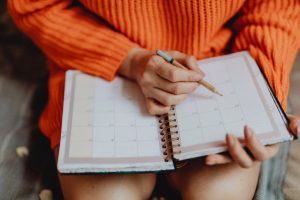
You get your periods, sit at home eating icecream on the couch, hot water bottle on the belly eating paracetamol and feeling sorry for yourself, then these few days pass and all of a sudden you’re the life and soul of the party oozing in sex appeal and confidence, full of energy and lust for life and any man that passes, you’re doing double takes. Boom few days pass again, and anyone who looks at you wrong is getting it in the neck, you can’t seem to fill the empty hole in your stomach, everything feels swollen, your boobs hurt, you want to divorce your husband and the glimpse of an old couple holding hands walking along the beach has you bawling like a baby. Any of these seem familiar? Welcome to life as a woman!!
Your Cycle
So, what’s going on here and why does my mood and body change so much throughout the month?
We as women work on a cycle of 28 days on average, a cycle which is split into 4 main phases.
Menstrual Phase Day 1-7
This is from the first day of your period. The uterine lining which had built up in preparation for pregnancy is now starting to shed as a result of an egg not being fertilised/met with sperm. Hormones oestrogen and testosterone are at their lowest here but start to climb on day 3 or 4. Many women may experience back ache, stomach cramping and low energy which should subside as hormones oestrogen and testosterone start to rise. This is a great week to start a diet as metabolism drops a little, leading to a decline in appetite and it favours carbs in this half of the cycle. Alllllllll the bread and pasta? Yes please! Our mood is also best here leading to a reduced risk of cravings.
Follicular Phase Day 5-14
Starts after the period ends and releases a hormone called FSH or follicle stimulating hormone to help release follicles with immature eggs to help be released in the next phase. The hormone oestrogen starts to rise here and thickens the uterine lining in preparation for a fertilized egg. Oestrogen is also known as the va-va-voom hormone, giving us energy, confidence and helps with the happy hormone serotonin. Testosterone also increases in this phase. Strength goes up and pain threshold increases, perfect time of the month for those heavy lifting sessions if you’re a gym goer or for booking that bikini wax or other pain inducing appointments. Our lust for life, speed at which we do things and memory are all optimal here so a perfect time for those jobs and deadlines you’re avoiding to get done. Sex drive increases as our bodies know it’s the perfect time for baby making. The wonders of mother nature eh? Arousal heightens and orgasm is easier to achieve in this phase. We’re also more attracted to men at this phase as your body seeks out an ideal baby making partner. Cervical mucus also increases here to help with the survival of sperm in preparation for an egg. This is a great time for trying to get pregnant as sperm can live in the body for up to 5 days.
Ovulation Day 14
Oestrogen is at its highest and the body produces LH or luteinizing hormone which spikes ovulation. This is when the egg is matured and released into the Fallopian tube awaiting the arrival of some sperm, to fertilize it(conception) Optimal time for baby making. An egg lives for roughly 24 hours until it’s fertilized and if not, it’s destroyed.
Luteal Phase Day 14-28
In this phase the egg that was released at ovulation forms into something called the corpus luteum. Oestrogen and testosterone drop off after ovulation but start to rise again in a few days. This can cause some women to become weepy just after ovulation. The corpus luteum releases progesterone which is our chill hormone. We tend to slow down at the start of this phase as progesterone kicks in, becoming more introverted. Energy levels start to drop and digestion can also slow down. We’re also more forgetful in this phase, a perfect time to blame your hormones for forgetting to take the bins out. If an egg is not fertilized after ovulation progesterone levels will start to drop, along with oestrogen and the body will prepare to break down the corpus luteum. Substances called prostaglandins are produced in this phase. These are inflammatory chemical messengers and can make an impact on how painful your period can be. Sex drive is at its lowest in the cycle here and orgasms are harder to reach. However, on a positive note metabolism increases meaning you can get away with eating more and your body will be sure to let you know this by increasing hunger. It prefers fat over carbs in this phase and fat burn through exercise increases by up to 30 percent. The second half of this phase, around day 21 oestrogen and testosterone plummet and can cause a zap in energy, and an increase in moodiness, anxiety and weepiness along with water retention. This is where people begin to see those PMS symptoms. Sex drive can increase here coming up to your period as nerve endings increase down there and cravings for food all increase as our body is naturally looking for ways to bring back up its serotonin.
We then hit the menstrual phase and start these wonderful phases over and over again!
Look out for our next blog on how I’ll discuss how to support the body in each phase.
